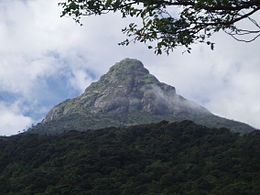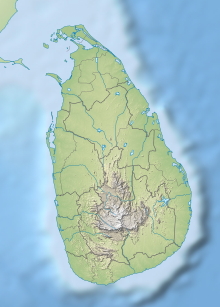Adam's Peak
This article needs additional citations for verification. (December 2017) |
| Adam's Peak | |
|---|---|
| Sri Pada | |
 Adam's Peak from a distance | |
| Highest point | |
| Elevation | 2,243 m (7,359 ft) |
| Coordinates | 6°48′34″N 80°29′59″E / 6.80944°N 80.49972°E |
| Naming | |
| Native name | |
| Geography | |
| Parent range | Samanala |
Adam's Peak is a 2,243 m (7,359 ft) tall conical
The mountain is also known as Mount Malaya in Buddhist sources, particularly the Mahayana Lankavatara Sutra, which states that the Buddha preached this sutra on top of the mountain. According to this sutra, the mountain was the abode of Rāvanā, overlord of the Raskshasas and ruler of Laṅkā.[5][6] Other names in Sanskrit sources include Mount Lanka, Ratnagiri (Mountain of Gems), Malayagiri (Mount Malaya) or Mount Rohana.[1]
The mountain is also seen as the abode of the deity Saman and also goes by various names associated with this, including Sumanakūta ("Sumana's Mountain") and Samanalakanda ("Mountain of Saman" or "Mountain of the Butterflies").[1][2]
Geography

The mountain is located in the southern reaches of the Central Highlands in the Ratnapura District and Nuwara Eliya District of the Sabaragamuwa Province and Central Province—lying about 40 km (25 mi) northeast of Ratnapura and 32 km (20 mi) southwest of Hatton. The surrounding region is largely forested hills, with no mountain of comparable size nearby. The region along the mountain is a wildlife reserve, housing many species varying from elephants to leopards, and including many endemic species.
Adam's Peak is important as a watershed. The districts to the south and the east of Adam's Peak yield precious stones—emeralds, rubies and sapphires, for which the island has been famous, and which earned for it the ancient name of Ratnadvipa.[7]
Adam's Peak is the source of three major rivers in Sri Lanka: Kelani River, Walawe River, and the Kalu Ganga (river).[8]
Trails
Access to the mountain is possible by 6 trails: Ratnapura–Palabaddala, Hatton–Nallathanni, Kuruwita–Erathna, Murraywatte, Mookuwatte and Malimboda. The Nallathanni and Palabaddala routes are most favoured by those undertaking the climb, while the Kuruwita–Erathna trail is used less often. These trails are linked to major cities or towns by bus, accounting for their popular use. The Murraywatte, Mookuwatte and Malimboda routes are seldom used but do intersect with the Palabaddala road midway through the ascent. The usual route taken by most pilgrims is ascent via Hatton and descent via Ratnapura. Although the Hatton trail is the steepest, it is also shorter than any of the other trails by approximately five kilometres.
Once one of the starting 'nodes' of Palabadalla, Nallathanni or Erathna is reached, the rest of the ascent is done on foot through the forested mountainside on the steps built into it. The greater part of the track leading from the base to the summit consists of thousands of steps built in cement or rough stones. The trails are illuminated with electric light, making night-time ascent possible and safe to do even when accompanied by children. Rest stops and wayside shops along the trails serve refreshments and supplies.
Whilst there are many ancient monuments on the mountain, there is an important
Nomenclature

Due to its multicultural and religious significance to the various people that inhabit the country, the mountain is referred to by a variety of names.
The often used Sri Pada is derived from
. Tamils may also use the name Shivanolipatha Malai to refer to the mountain.Another
Other local and historic names include Ratnagiri ("jewelled hill"), Samantakuta ("Peak of Saman"), Svargarohanam ("the climb to heaven"), Mount Rohana and other variations on the root Rohana.
History

Sri Pada is mentioned in the 5th-century chronicle
The Italian merchant
Sacred mountain


It is revered as a holy site by Buddhists, Sri Lankan Hindus, and some Muslims and Christians. It has specific qualities that cause it to stand out and be noticed, including its dominant and outstanding profile, and the boulder at the peak containing an indentation resembling a footprint. According to the Encyclopædia Britannica Eleventh Edition:
For a long period Adam’s Peak was supposed to be the highest mountain in Ceylon, but actual survey makes it only 7353 ft. above sea-level. This elevation is chiefly remarkable as the resort of pilgrims from all parts of the East. The hollow in the lofty rock that crowns the summit is said by the
It is an important pilgrimage site, especially for Buddhists. Pilgrims walk up the mountain, following a variety of difficult routes up thousands of steps. The journey takes several hours at least.
The mountain is most often scaled from December to May. During other months it is hard to climb the mountain due to very heavy rain, extreme wind, and thick mist. The peak pilgrimage season is in April, and the goal is to be on top of the mountain at sunrise when the distinctive shape of the mountain casts a triangular shadow on the surrounding plain and can be seen to move quickly downward as the sun rises.
Legends

For Buddhists, the footprint mark is the left foot of the Buddha, left behind when Buddha visited Sri Lanka, as a symbol for worship at the invitation of the Buddhist god Saman.
Tamil Hindus consider it the footprint of Shiva. It is also fabled that the mountain is the legendary mount Trikuta, the capital of Ravana in the Ramayana from where he ruled Lanka.
A bell lies on top of the temple and tradition holds that pilgrims can ring it as many times as they have achieved the pilgrimage to the top of the peak.
A shrine to Saman, a Buddhist deity (people who have spent spiritual lives during their life on earth and done pacificist service are deified by Sri Lankan Buddhists) charged with protecting the mountain top, can be found near the footprint.
See also
References
- ^ a b c "Sri Pada - Buddhism's Most Sacred Mountain, Sri Lanka". www.buddhanet.net. Retrieved 8 January 2023.
- ^ a b c Capper, Daniel (2022), Roaming Free Like a Deer: Buddhism and the Natural World, Cornell University Press.
- ^ "Seruwila to Sri Pada (Sacred Foot Print Shrine)". UNESCO.org. Retrieved 25 August 2011.
- ISBN 978-0-226-71088-4.
- ^ William Edward Soothill and Lewis Hodous. A Dictionary of Chinese Buddhist Terms: With Sanskrit and English Equivalents and a Sanskrit-Pali Index, p. 402. Psychology Press, 2003
- ^ "Rāvanā & Sinhala Buddhism: A Strained Relationship Ridden With Contradictions". Colombo Telegraph. 29 July 2015. Retrieved 8 January 2023.
- ^ Palihapitiya. "P.G.G." Retrieved 28 September 2012.
- ^ "Sri Pada". lovidhu.com. Retrieved 25 February 2021.
- ^ Paranavitana, S. (1958). The god of Adam's Peak. Artibus Asiae. pp. 11–22.
- ^ Manjula, H.A.K.L. (5 March 2021). "Sri Pada (Adam's Peak)". Lankapradeepa. Retrieved 29 September 2023.
- ^ Yule, Henry; Cordier, Henri (1903). The Book of Ser Marco Polo (Volume 2) (3rd ed.). London: John Murray. pp. 316–330.
- ^ Sanguinetti, B.R.; Defrémery, C., eds. (1858). Voyages d'Ibn Batoutah (Volume 4) (in French and Arabic). Translated by Defrémery, C.; Sanguinetti, B.R. Paris: Société Asiatique. pp. 179–182.
- ISBN 978-0-904180-37-4.
- ISBN 0-520-24385-4.
- ^ J. Penry Lewis: List of Inscriptions on Tombstones and Monuments in Ceylon of Historical or Local Interest with an Obituary of Persons Uncommemorated, Colombo: H. C. Cottle, Government Printer, 1913, p. 422.
- ^ Davy, John (1818). "A description of Adam's Peak. By John Davy, M.D. F.R.S. In a letter addressed to Sir Humphry Davy F.R.S. LL.D. Colombo May 1st 1817". The Journal of Science and the Arts. 5: 25–30.
- ^ One or more of the preceding sentences incorporates text from a publication now in the public domain: Chisholm, Hugh, ed. (1911). "Ceylon". Encyclopædia Britannica. Vol. 5 (11th ed.). Cambridge University Press. p. 778.
Further reading
- Skeen, William (1870). Adam's Peak: Legendary, Traditional, and Historic Notices of the Samanala and Srí Páda. Colombo, Ceylon: W.L.H. Skeen.

